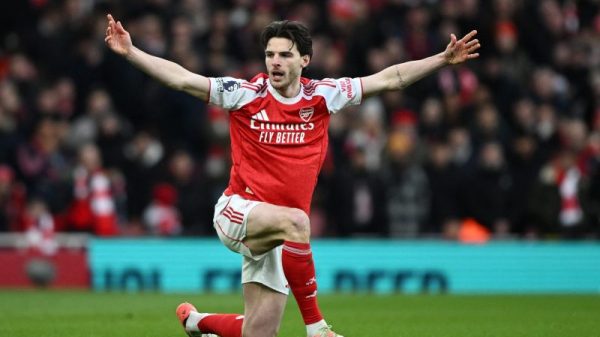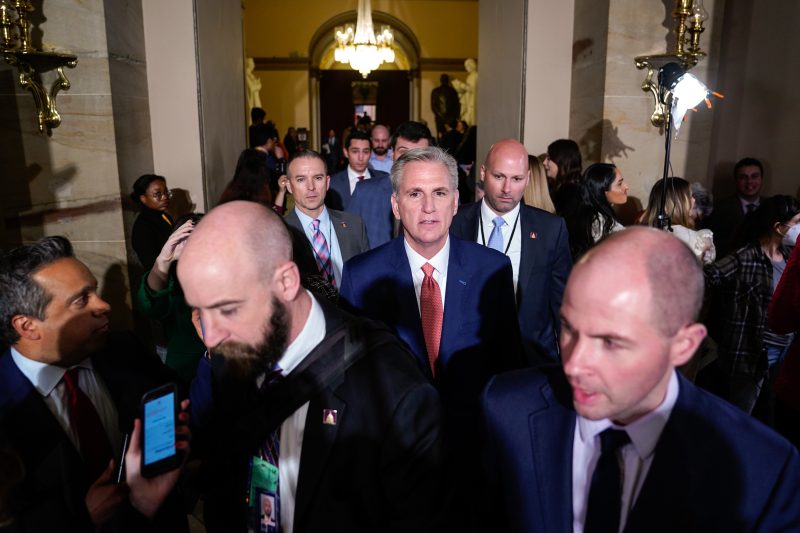House Speaker Kevin McCarthy (R-Calif.) has provided exclusive access to a trove of U.S. Capitol surveillance footage from the Jan. 6, 2021, insurrection to Fox News host Tucker Carlson, who has played down the deadly violence that occurred that day and claimed it was a “false flag” operation.
McCarthy has declined to comment on the unprecedented move, but Carlson said Monday night on his program that his producers have been granted “unfettered” access to security video recorded when hundreds of President Donald Trump’s supporters stormed the Capitol to stop the certification of Joe Biden’s electoral college win. Five people died as a result of the attack, and 140 members of law enforcement were injured as the mob used flagpoles, bear spray, baseball bats and other weapons against police.
“So there’s about 44,000 hours, and we have — you may have read today — been granted access to that. … We believe we have secured the right to see whatever we want to see. We’ve been there about a week. Our producers, some of our smartest producers, have been looking at this stuff and trying to figure out what it means and how it contradicts or not the story we’ve been told for more than two years. We think already in some ways that it does contradict that story.”
Carlson said his producers would spend the rest of the week assessing the video and air what they found next week. (U.S. Capitol Police had previously said they shared 14,000 hours of footage with the House select committee investigating the riot.)
The decision by McCarthy, who has not spoken publicly or responded to questions about the release, was first reported by Axios on Monday.
Carlson, the network’s most-watched prime-time host, has repeatedly cast doubt on official accounts of what happened on Jan. 6 shared last year by the House select committee. Instead, he has repeated baseless theories that the federal government instigated the attack and blasted the committee, even giving airtime to former Trump strategist Stephen K. Bannon hours after he had been convicted of contempt. Carlson produced a three-part documentary, “Patriot Purge,” advancing a false claim that FBI operatives were behind the assault and arguing that the Jan. 6 rioters were innocent.
The decision by McCarthy to provide the video to Carlson raised serious questions about whether the release of the footage would force U.S. Capitol Police to change the location of security cameras and why the speaker would give the material to a Fox News host who has peddled conspiracy theories about the attack and not share it with other news organizations.
Representatives for Fox News did not respond to requests for comment on Tuesday.
McCarthy, who made concessions to the far-right flank of his GOP conference to win enough votes to become speaker, has said that Republicans would investigate the work of the bipartisan Jan. 6 committee. McCarthy also vowed that Republicans would launch their own inquiry into “why the Capitol complex was not secure” that day.
Shortly after the Axios report, Rep. Marjorie Taylor Greene (R-Ga.), a McCarthy ally who has called those facing charges for the Jan. 6 attack “political prisoners,” hailed the decision to provide the footage solely to Carlson while taking credit for her backing of McCarthy.
“Get ready for the truth from J6 because the video tapes are coming!” she tweeted Monday. She also wrote: “I’m very happy to be right again in my support for Kevin McCarthy as our Speaker.”
For all of you that doubted we would release the tapes.
Here you go!
I’m very happy to be right again in my support for Kevin McCarthy as our Speaker.
Americans deserve to see the truth, not a one sided narrative and unfair two tiered justice system.https://t.co/EkVvbTwxcP
— Rep. Marjorie Taylor Greene (@RepMTG) February 20, 2023
Trump has tried to blame Rep. Nancy Pelosi (D-Calif.), the former speaker, for the Capitol breach, falsely suggesting that the absence of enough security to turn back the mob was her responsibility, not that of the commander in chief. He has also falsely claimed Pelosi rejected his order for 10,000 National Guard troops — something that never happened.
McCarthy told reporters last month that he supported the idea of additional footage from the riot being made public. “I think the public should see what has happened on that,” he said.
Asked about the footage, Capitol Police Chief Tom Manger said on Tuesday: “When congressional leadership or oversight committees ask for things like this, we have no choice but to give it to them.”
McCarthy’s decision to provide Carlson with the video drew harsh criticism over the security risks of handing over footage that could contain information about the Capitol’s complex security apparatus.
In a letter to fellow Democrats, House Minority Leader Hakeem Jeffries (N.Y.) said party members were working to learn more about the “egregious security breach.”
“I write with respect to public reports that extreme MAGA Republicans in the House have provided tens of thousands of hours of sensitive Capitol security footage to a FOX News personality who regularly peddles in conspiracy theories and Pro-Putin rhetoric,” he said Tuesday, referring to Carlson. “The apparent transfer of video footage represents an egregious security breach that endangers the hardworking women and men of the United States Capitol Police, who valiantly defended our democracy with their lives at risk on that fateful day.”
Jeffries said House Democrats would hold their virtual caucus meeting Wednesday with presentations from Rep. Bennie G. Thompson (Miss.), who was chairman of the Jan. 6 committee and is the top Democrat on the House Homeland Security panel, and Rep. Joseph Morelle (N.Y.), the top Democrat on the House Administration Committee.
Thompson said Monday that there could be major security risks if the video footage were used irresponsibly.
“If Speaker McCarthy has indeed granted Tucker Carlson — a Fox host who routinely spreads misinformation and [Russian President Vladimir] Putin’s poisonous propaganda — and his producers access to this sensitive footage, he owes the American people an explanation of why he has done so and what steps he has taken to address the significant security concerns at stake,” Thompson said in a statement late Monday.
Rep. Jamie B. Raskin (D-Md.), who was a member of the Jan. 6 committee, told The Washington Post’s Early 202 newsletter that the videos could be used by Carlson to prop up his misleading allegations.
“Undoubtedly he’ll be searching for any kind of shot that could support this deranged theory of what happened on January 6th,” Raskin said. “If you want to make tens of thousands of hours publicly available, then it should be available for all media, not for just one propaganda mouthpiece.”
Tim Mulvey, a former senior staff member and spokesman for the Jan. 6 committee, said in a statement that when the panel obtained access to U.S. Capitol Police video footage, “it was treated with great sensitivity given concerns about the security of lawmakers, staff, and the Capitol complex. Access was limited to members and a small handful of investigators and senior staff, and the public use of any footage was coordinated in advance with Capitol Police. It’s hard to overstate the potential security risks if this material were used irresponsibly.”
People familiar with the footage say the committee investigating the Jan. 6 riot had access to a special dedicated terminal installed in the committee office that had password-protected access to the material. The committee asked for permission from U.S. Capitol Police before they used any of the footage in public hearings, these people said, as the panel did not want to publicly disclose the location of security cameras in the building.
The committee cut and minimized use of the footage accordingly, these people added.
“We used the material that we thought was most important in demonstrating findings, and we were extremely cautious in what we chose to use,” said a former committee staffer who expressed concerns about the security risks posed by Carlson’s access to the entire trove of surveillance footage. The individual spoke on the condition of anonymity to talk freely about the internal work of the panel.
Tom Jackman contributed to this report.



























